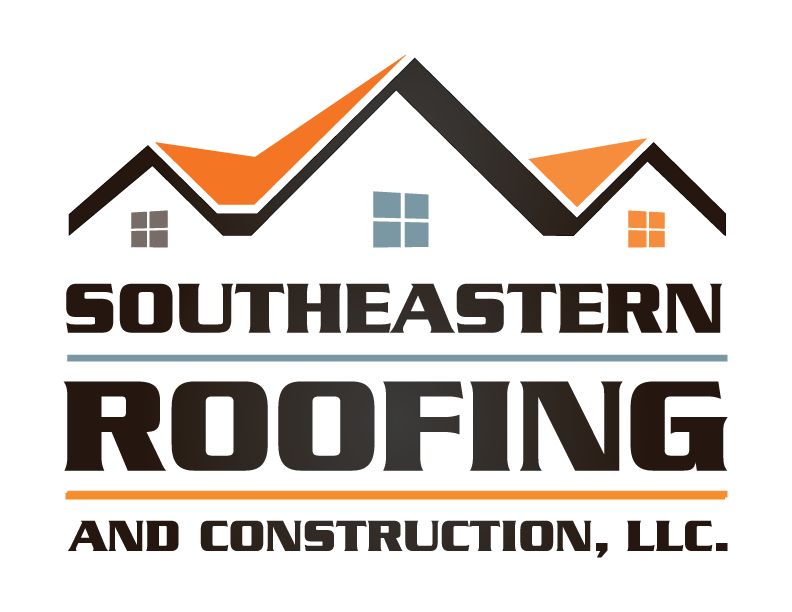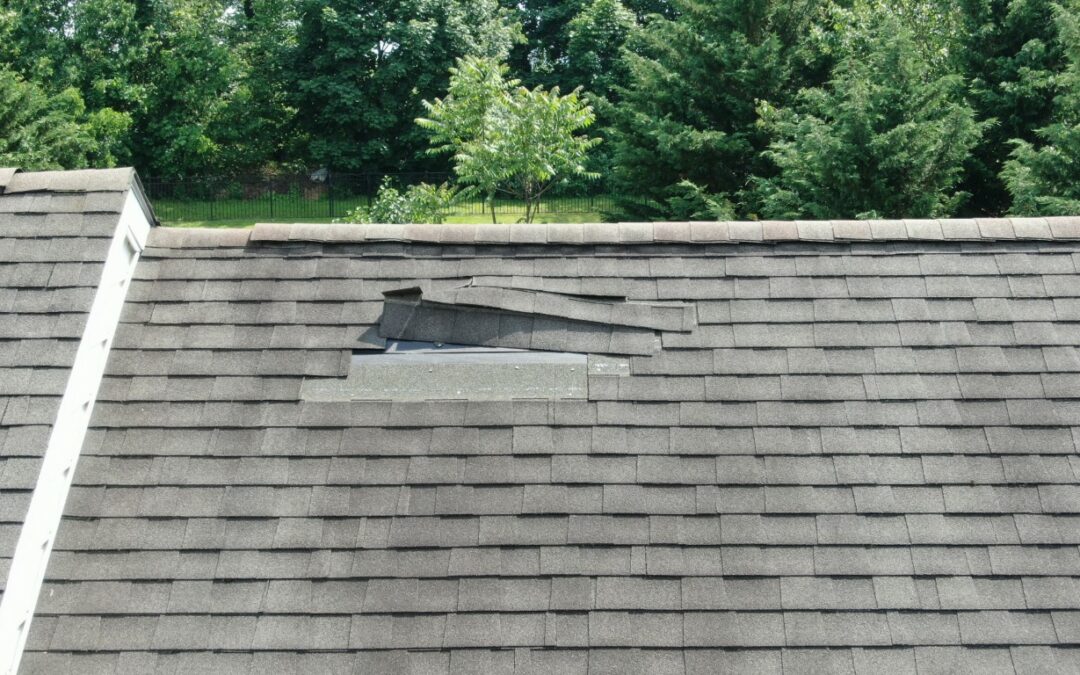Ladies and gentlemen, we’ve got your back when it comes to protecting your beloved abode. Wondering how to spot symptoms of roof damage before it gets out of hand? Look no further!
In this article, we’ll share the 8 best ways to keep your roof in tip-top shape. From dark spots on the ceiling to granules in the gutters, we’ll guide you through the signs that may indicate trouble overhead.
Stay tuned for expert advice and give your roof the attention it deserves.
Key Takeaways
- Dark spots or stains on the ceiling indicate water leaks or moisture buildup
- Missing or cracked shingles are clear signs of roof damage
- Leaks or water stains in the attic indicate potential roof problems
- Regular maintenance can prevent water damage and the formation of dark spots
Dark Spots or Stains on the Ceiling
One way we can spot symptoms of roof damage is by looking for dark spots or stains on the ceiling. These unsightly marks are often caused by water leaks or moisture buildup resulting from a damaged roof.
When the roof is compromised, water can seep through and collect in the attic or ceiling space, leading to the formation of dark spots. The causes of these stains can vary, including missing or cracked shingles, damaged flashing, or clogged gutters that cause water to overflow onto the roof.
To prevent roof stains, it’s crucial to address any roof damage promptly. Regular maintenance, such as inspecting and repairing shingles, keeping gutters clean and free of debris, and ensuring proper attic ventilation, can help prevent water damage and the formation of dark spots on the ceiling.
Missing or Cracked Shingles
We often notice missing or cracked shingles as a clear sign of roof damage. When conducting roof maintenance, it’s crucial to inspect the shingles regularly for any signs of damage.
Missing shingles can leave your roof vulnerable to water leaks and further deterioration. Cracked shingles can also indicate underlying issues, such as age or improper installation. If you notice any missing or cracked shingles, it’s important to address them promptly to prevent further damage.
Depending on the extent of the damage, you may need to replace the affected shingles or consider a roof repair. By addressing missing or cracked shingles promptly, you can ensure the longevity and functionality of your roof.
Now, let’s move on to the next section, where we discuss leaks or water stains in the attic, which can also indicate roof damage.
Leaks or Water Stains in the Attic
Continuing our inspection for roof damage, let’s now turn our attention to leaks or water stains in the attic.
Leaks or water stains in the attic can indicate a potential roof problem that needs immediate attention. When water infiltrates the attic, it can cause extensive damage, including mold growth and compromised attic insulation. Moisture damage can weaken the structural integrity of your roof and lead to costly repairs.
To spot leaks or water stains in the attic, carefully examine the ceiling and walls for any signs of water infiltration. Look out for discoloration, bubbling paint, or a musty smell, as these are indications of water damage.
If you notice any of these symptoms, it’s crucial to address the issue promptly to prevent further damage and maintain the integrity of your attic insulation.
Sagging or Uneven Roofline
As we examine the symptoms of roof damage, it’s important to look out for a sagging or uneven roofline. A sagging or uneven roofline can be an indication of structural issues that require immediate attention.
When conducting a roofline inspection, start by standing back and visually inspecting the roof. Look for any areas where the roofline appears to dip or slope unevenly. Additionally, check for any visible signs of damage, such as cracked or missing shingles, as these can contribute to a sagging roofline.
If you notice any issues, it’s crucial to contact a professional for roofline repair. Ignoring a sagging or uneven roofline can lead to further damage and potential safety hazards.
Granules in Gutters or Downspouts
One common symptom of roof damage is finding a significant amount of granules in the gutters or downspouts. When inspecting your gutters and downspouts, it’s important to keep an eye out for these granules, as they can indicate that your roof is deteriorating.
Regular gutter maintenance is crucial in preventing granule loss and prolonging the lifespan of your roof. By regularly cleaning your gutters and downspouts, you can remove any accumulated debris that may cause water to back up and damage your roof.
Additionally, installing gutter guards can help prevent granules from entering and clogging your gutters. Another way to prevent granule loss is to ensure proper roof ventilation, as excessive heat and moisture can cause the asphalt shingles to deteriorate and shed granules.
Excessive Moss or Algae Growth
To identify excessive moss or algae growth on your roof, we need to look out for signs of green patches or discoloration. These patches can appear on the shingles, especially in areas that receive less sunlight or have excess moisture. Excessive moss or algae growth isn’t only unsightly, but it can also cause damage to your roof if left unchecked.
Moss and algae can retain moisture, leading to the deterioration of the shingles and potentially causing leaks. To prevent roof damage caused by moss or algae, regular roof maintenance is crucial. This includes keeping the roof clean and free from debris, as well as trimming overhanging branches to allow more sunlight onto the roof.
Additionally, applying a moss or algae-resistant treatment can help prevent their growth and protect your roof from damage.
Visible Signs of Roof Aging
As experts in roof damage, we’ve identified several visible signs that indicate roof aging. Cracked shingles are a clear indication that your roof is getting older, as they can no longer provide proper protection.
Another sign is sunlight filtering through your attic, which suggests that your roof may have developed gaps or holes over time. Additionally, a sagging roof is a strong indicator of aging, as it can result from structural deterioration and the weakening of support beams.
Cracked Shingles Indicate Aging
We can easily identify the aging of a roof by spotting cracked shingles, which are clear indicators of wear and tear. Cracked shingles are one of the most obvious signs of an aging roof and shouldn’t be ignored. Over time, exposure to the elements, including harsh sunlight, rain, and wind, can cause shingles to become brittle and crack.
When shingles are cracked, they become less effective at protecting the underlying structure of the roof from water damage, which can lead to more serious issues such as leaks and structural damage. It’s important to regularly inspect your roof for cracked shingles and address any issues promptly to prevent further damage. As we move on to the next section, it’s worth mentioning that another visible sign of roof aging is sunlight seeping through the attic.
Sunlight Through Attic Signals Aging
Moving on to the next visible sign of roof aging, we can easily spot the indication of sunlight seeping through the attic. This is one of the most obvious signs of roof deterioration and shouldn’t be ignored.
When sunlight penetrates through the attic, it means that there are openings or gaps in the roof structure that allow light to pass through. These openings can be caused by various factors such as missing or damaged shingles, cracked flashing, or even holes in the roof.
Sunlight penetration not only indicates an aging roof but also poses a potential risk for water leaks, which can lead to further damage if left unaddressed. Therefore, it’s crucial to inspect your attic regularly for any signs of sunlight seeping through and take immediate action to prevent further deterioration.
Sagging Roof Signals Aging
How can we identify if a sagging roof is a sign of aging?
One of the most obvious signs of an aging roof is sagging. When a roof starts to sag, it’s often an indication that the underlying structure is weakening over time. This can be caused by various factors, such as poor construction, inadequate roof maintenance, or even the weight of accumulated snow or water.
If you notice any sagging in your roof, it’s crucial to address the issue promptly to prevent further damage and potential roof collapse. Hiring a professional for roof repair and maintenance is essential in such cases. Regular inspections and proactive repairs can help extend the lifespan of your roof and ensure that it remains structurally sound for years to come.
Now let’s explore another visible sign of roof aging – interior temperature fluctuations.
Interior Temperature Fluctuations
During our investigation of roof damage symptoms, we discovered that interior temperature fluctuations can be a clear indication of potential issues.
A well-maintained roof plays a vital role in maintaining a comfortable and consistent indoor environment. If you notice sudden changes in temperature within your home, it could be a sign of roof damage. A damaged roof can compromise the insulation of your home, leading to heat loss in the winter and heat gain in the summer. This can result in increased energy consumption, leading to higher utility bills.
Additionally, interior temperature fluctuations can make it difficult to maintain proper interior humidity control, which can affect the overall comfort of your living space. It’s important to address any temperature fluctuations promptly to ensure the energy efficiency and comfort of your home.
Conclusion
In conclusion, being able to spot the symptoms of roof damage is crucial for maintaining the integrity of your home. By keeping an eye out for dark spots, missing shingles, leaks, and other signs, you can address issues before they worsen. Don’t ignore the warning signs – they could be a signal of a larger problem. So, be vigilant and take action to protect your home and ensure its longevity.

